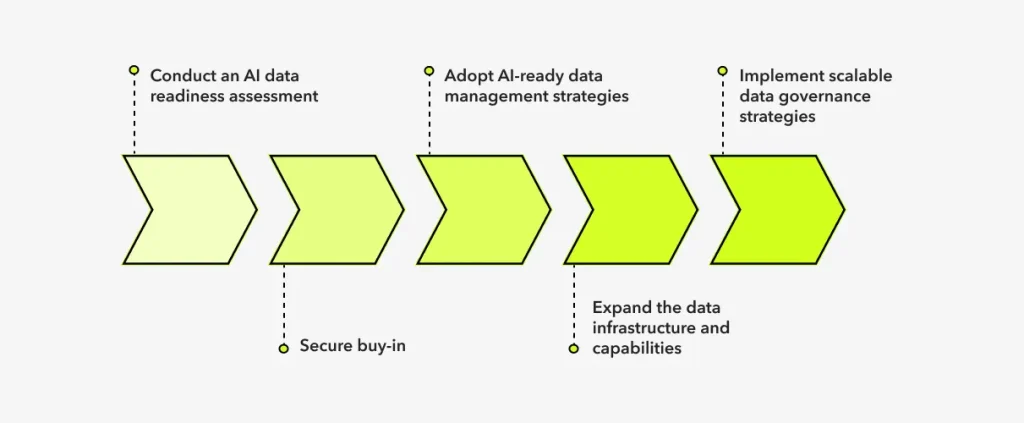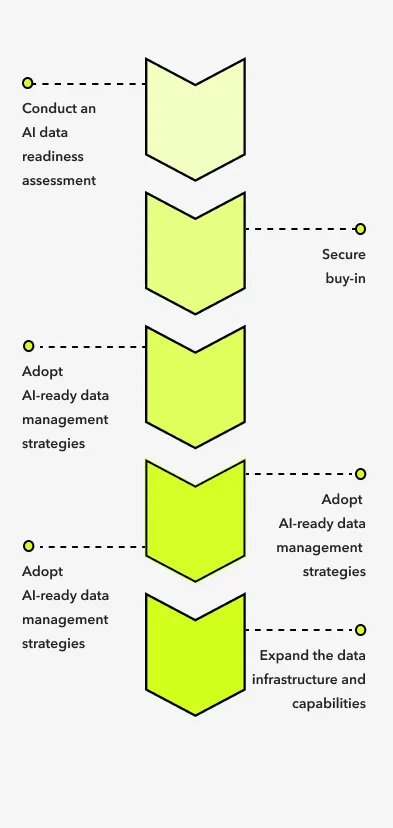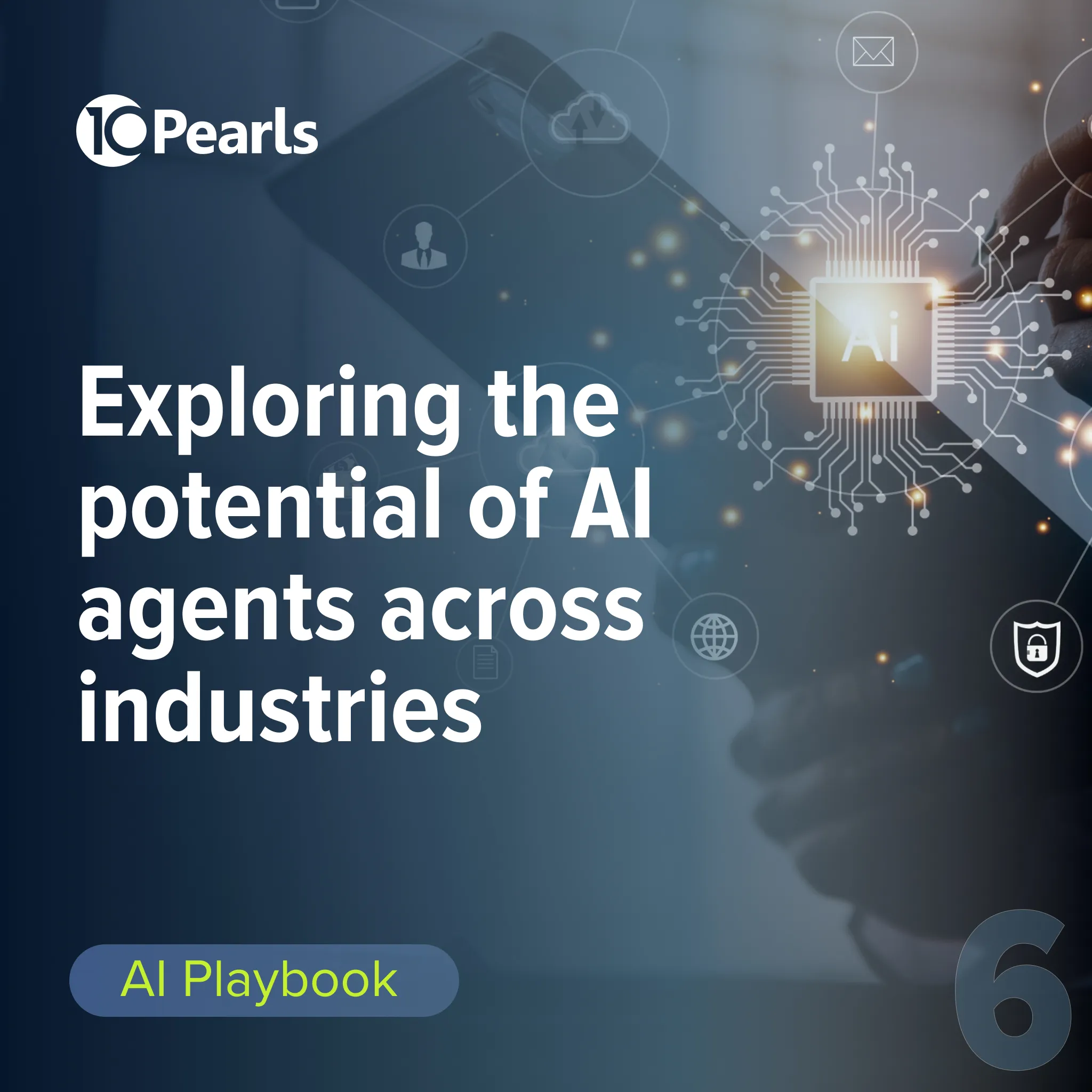AI Data Readiness Roadmap & Guidance
By 10Pearls editorial team
A global team of technologists, strategists, and creatives dedicated to delivering the forefront of innovation. Stay informed with our latest updates and trends in artificial intelligence, advanced technology, healthcare, fintech, and beyond. Discover insightful perspectives that shape the future of industries worldwide.
Data is the backbone of artificial intelligence (AI). An AI application’s efficacy and accuracy depend heavily on the quantity and quality of data fed to it. As such, special care must be taken to select and prepare AI-ready data. A lack of AI data readiness could have severe consequences, with Gartner® research from A Journey Guide to Delivering AI Success Through ‘AI-Ready’ Data predicting that “organizations that don’t enable and support their AI use cases through an AI-ready data practice will see over 60% of AI projects fail.”
The importance of AI data readiness can’t be overstated, but AI-ready data requirements differ significantly from traditional data management strategies, creating challenges for organizations. This blog provides a thorough overview of what AI data readiness means before offering a five-step roadmap to get your data AI-ready.

What is AI data readiness?
There are three essential characteristics of AI-ready data:
Alignment with business use cases
Meeting quality
requirements
Meeting governance
requirements
AI use case data alignment factors
An organization establishes AI data readiness by clearly defining the data requirements for each AI use case. These requirements will likely evolve as data is used by AI applications in production. Some of the factors to consider while aligning data to specific AI use cases are listed below.
| AI technology | Different types of artificial intelligence technologies, like generative AI and computer vision, require differing types and quantities of data. |
| Quantity | How much data is needed will also vary depending on the use case, though any AI deployment requires a large volume of usable data. |
| Annotation and labeling | Data needs to be properly annotated and labeled so the AI model knows how to identify the information contained within. |
| Quality | It’s crucial to ensure that data meets the specific quality standards for each use case, including identifying errors and outliers. |
| Trust | The various data sources must be reliable and diverse, with special care taken to avoid bias and other ethical concerns. |
AI-ready data meets quality requirements
AI data should be continuously validated to ensure it meets quality requirements at all stages of training, development, and production usage. Below are some of the parameters for ensuring continuous quality.
| Continuous validation | Data should be regularly tested to ensure it continues to meet quality requirements during AI development and usage. |
| Response time | It’s critical to ensure that data performance adheres to service level agreements (SLA) for response time. |
| Versioning | Data changes and versions should be tracked and managed to mitigate drift and other data pipeline issues. |
| Regression testing | Data drift and failures should also be mitigated with continuous regression testing using custom test cases. |
| Observability | Metrics should be established to monitor and ensure data health, performance, and accuracy. |
AI-ready data meets governance requirements
An organization’s AI data readiness is evidenced by its AI-specific governance policies, practices, and technologies. Here are some of the data governance requirements for AI-ready data.
| Data stewardship | Consistent policies should be applied throughout the entire data lifecycle, with roles and responsibilities clearly defined. |
| Compliance | AI data must comply with regulations for privacy and security, including new, AI-specific laws like the AI EU Act. |
| Ethics | Special care must be taken to ensure the transparency of AI data usage and mitigate ethical issues like training with real customer data. |
| Fairness | It’s important to proactively mitigate data bias and routinely test models to ensure fair decisions. |
| Sharing | To support new and changing AI use cases, data architectures should enable safe sharing among various AI tools. |
5-Steps AI data readiness roadmap
There are five essential steps organizations can take to establish AI data readiness.


1. Conduct an AI data readiness assessment
The best way to start is by assessing your current data management practices to identify weaknesses and determine where to target your efforts. Organizations without sufficient AI experience to thoroughly evaluate AI data readiness should partner with an established firm like 10Pearls to perform this assessment and learn the next steps.
2. Secure executive buy-in
Restructuring your data practices and architecture to support AI requires a lot of major organizational changes, so it’s absolutely crucial that you shore up support from executives and other business leaders. The rest of the organization will follow their lead, making it easier to implement the necessary changes. An AI consulting firm like 10Pearls can help by creating customized, high-level executive reports that highlight the business benefits of implementing AI-ready data practices.
3. Adopt AI-ready data management strategies
We discussed several AI-specific data management practices and strategies above. This step involves adopting new policies, tools, and practices, or modifying your existing strategies to meet the requirements of your AI use cases. This step can be the most complicated, so many organizations may find it beneficial to work with outside AI implementation experts like 10Pearls to ensure a smooth transition.
4. Expand the data infrastructure and capabilities
The underlying technical data infrastructure needs to support not just your current AI initiatives but also any new or evolving use cases that may arise. This step may involve refactoring on-premises storage architectures, migrating data to the cloud, or integrating new tools into data pipelines. Working with migration and modernization experts like 10Pearls can significantly reduce the challenges involved and help eliminate the chances of business disruption.
5. Implement scalable data governance strategies
Your new data governance practices must be able to grow with your AI capabilities to ensure scalability without compromising quality, safety, or ethics. Anticipating your future needs can be challenging, especially without prior AI experience, which is why it’s recommended to consult with AI experts when developing your data governance strategy.
Maximize your AI data readiness
10Pearls has the proven expertise to help your organization adopt AI-ready data practices and implement safe, scalable AI data architectures. Reach out to schedule a risk-free consultation with our AI data readiness experts.

Get in touch with us
Related articles







